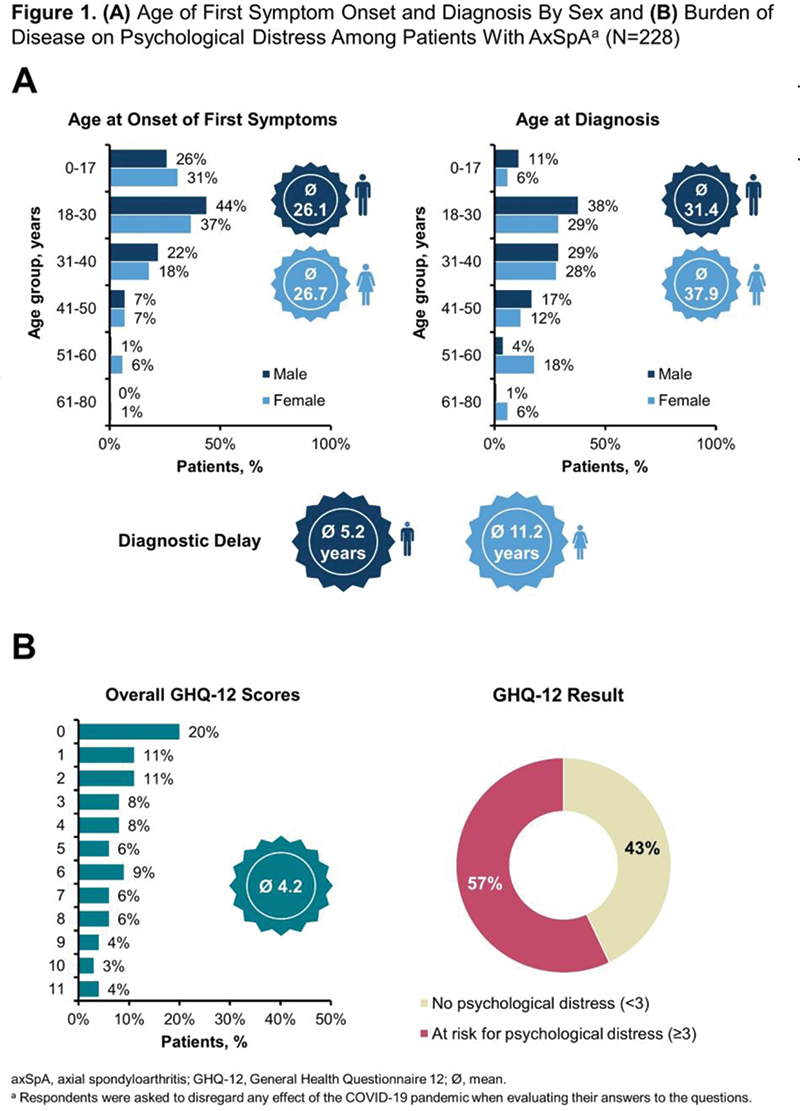

Background: Axial spondyloarthritis (axSpA) is a chronic inflammatory disease encompassing radiographic (traditionally known as ankylosing spondylitis) and non-radiographic forms that lead to chronic pain, structural damage, and disability. 1 The International Map of Axial Spondyloarthritis (IMAS) survey is an initiative developed to generate insights into the real-life experiences of people living with axSpA to ultimately improve quality of life. 2
Objectives: To assess the burden and daily experience of patients with axSpA in the United States.
Methods: The IMAS survey generates a report on patient-reported aspects of disease burden and experience with axSpA using adaptations of the original Atlas of axSpA questionnaire developed in collaboration with patients, the Axial Spondyloarthritis International Federation, and clinical academic experts. In this US adaptation of the IMAS survey, a 30-minute quantitative online survey was administered to US patients aged ≥18 years who completed screening questions, self-reported having been diagnosed with axSpA by a healthcare provider, and were under the care of a healthcare provider between July 22, 2021, and November 10, 2021. Survey questions were tailored to reflect differences in the US healthcare systems and the availability of treatments. This analysis presents a portion of the US data describing patient demographics, clinical characteristics, journey to axSpA diagnosis, and the emotional impact and overall burden of disease on quality of life using the General Health Questionnaire 12 (GHQ-12), the Assessment of SpondyloArthritis international Society – Health Index (ASAS-HI), and a global limitation index of 18 activities of daily living. All results were reported descriptively using summary statistics.
Results: Survey data from 228 US patients with axSpA were collected in this analysis. The mean age was 45 years, 60% of patients were female, and the mean BMI was 27.7 kg/m
2
(
Patient Demographic and Clinical Characteristics
| Characteristic | Patients with axSpA(N=228) |
|---|---|
| Mean age, years | 45 |
| Female, % | 60 |
| White, % | 86 |
| Mean body mass index, kg/m 2 | 27.7 |
| Nonsmoker, % | 62 |
| Alcohol consumption behavior, % | |
| Never | 19 |
| Every day | 9 |
| Mean number of comorbidities | 5.6 |
| Common comorbidities (≥20% of patients), % a | |
| Anxiety | 43 |
| Depression | 41 |
| Hypertension | 32 |
| Obesity/overweight | 31 |
| Sleep disorders | 30 |
| Hypercholesterolemia | 29 |
| Uveitis | 24 |
| Psoriatic arthritis | 23 |
| Fibromyalgia | 20 |
| Spinal or other fractures | 20 |
| Psoriasis | 20 |
| Employed, % | 54 |
axSpA, axial spondyloarthritis.
a Respondents could have selected ≥1 answer.
Conclusion: This study showed that a high proportion of US patients with axSpA report impaired function and are at risk for psychological distress. Patients also experienced a substantial delay in the time to axSpA diagnosis, with longer delays than those reported in the European Union. Delays were twice as long in women compared to men. These findings highlight the large impact of disease on daily activities and mental distress in US patients with axSpA.

REFERENCES:
[1]Sieper J, Poddubnyy D. Lancet . 2017;390:73-84.
[2]Garrido-Cumbrera M, et al. Curr Rheumatol Rep . 2019;21:19.
Acknowledgements: This study was funded by Novartis Pharmaceuticals Corporation, East Hanover, NJ, USA. Medical writing support was provided by Charli Dominguez, PhD, of Health Interactions, Inc, Hamilton, NJ, USA, and was funded by Novartis Pharmaceuticals Corporation. This abstract was developed in accordance with Good Publication Practice (GPP3) guidelines. Authors had full control of the content and made the final decision on all aspects of this publication.
Disclosure of Interests: Marina Magrey Consultant of: Received consulting fees from Eli Lilly and Novartis, Grant/research support from: Received research grants from AbbVie, Amgen, and UCB, Jessica A. Walsh Consultant of: Received consulting fees from Amgen, Janssen, Eli Lilly, Novartis, Pfizer, and UCB, Grant/research support from: Received research funding from AbbVie, Merck, and Pfizer, Sandra Flierl Employee of: Employee of Ipsos, Renato Calheiros Employee of: Employee of Novartis, David Wei Employee of: Employee of Novartis, Muhammad Asim Khan Consultant of: Has served as a consultant for Novartis